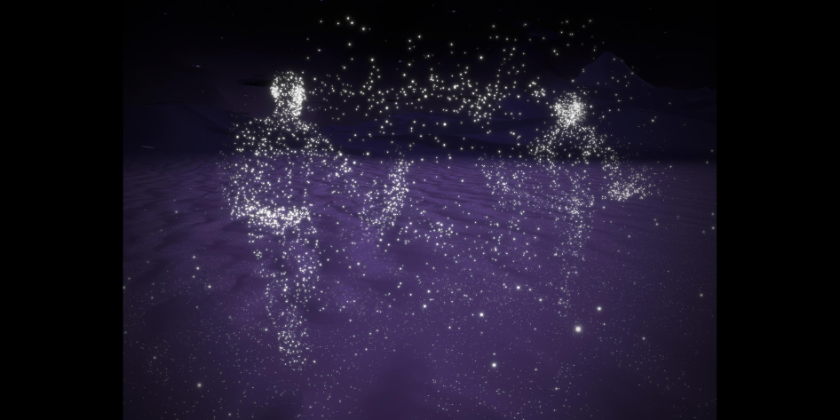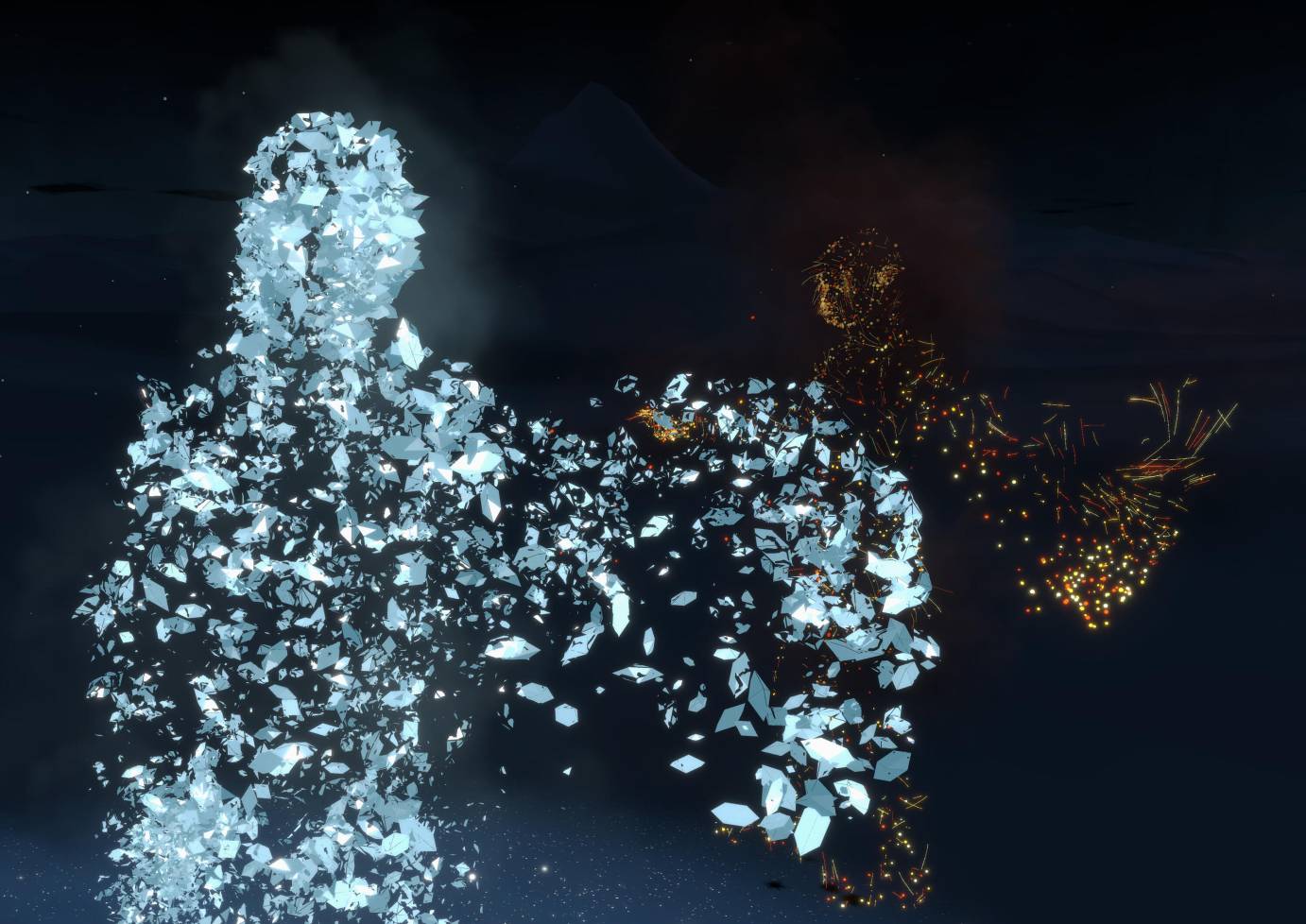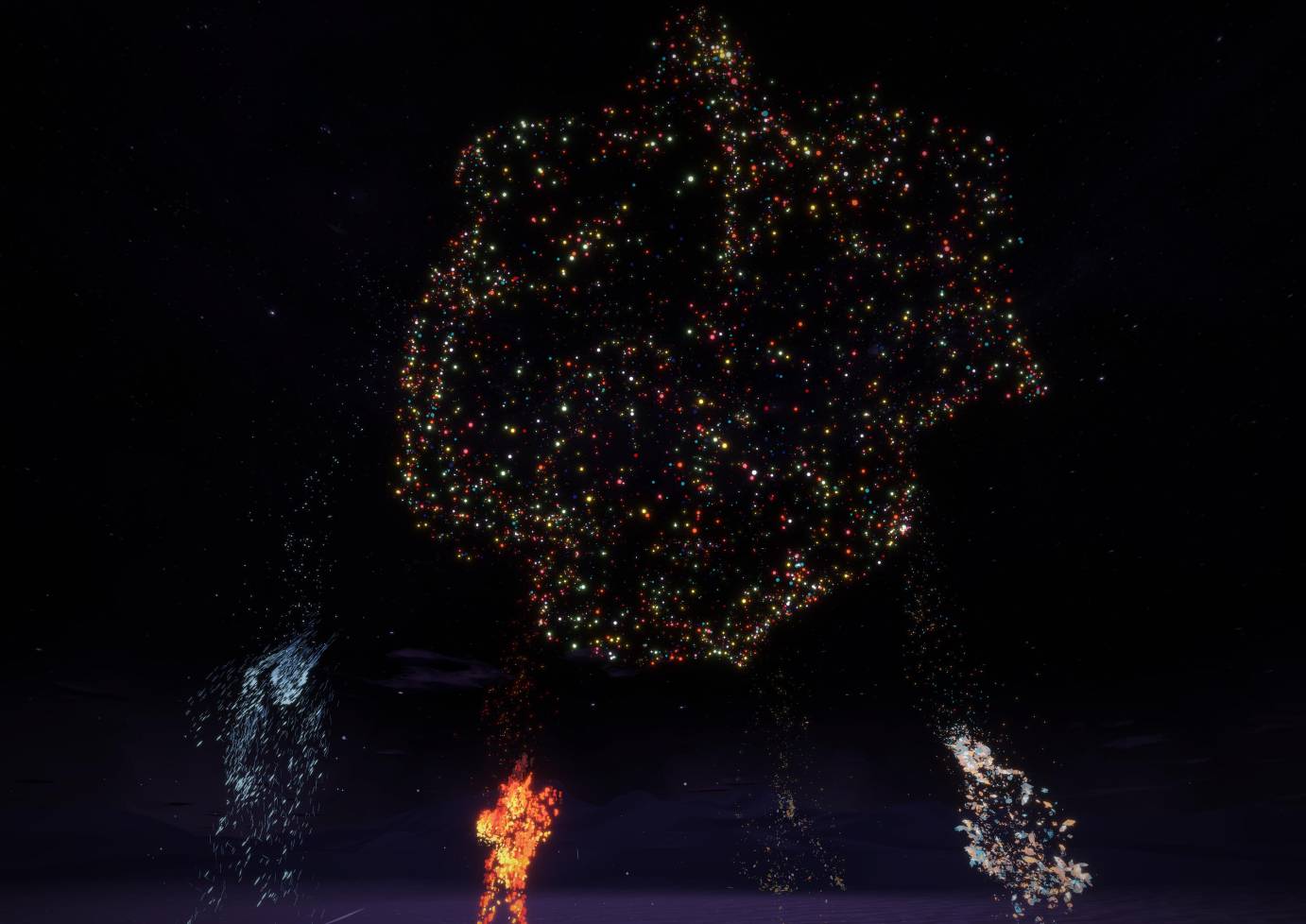
Published on October 20, 2025
Photo credit: Collective Body courtesy of Lincoln Center
Creator / Director: Sarah Silverblatt-Buser
Music composer: Harvey Causon
Producers: Oriane Hurard, Aurélie Leduc, Arnaud Colinart
Technical director & developer: Ferdinand Dervieux
Lead Artist: Arthur Maugendre
Sound Designer: Côme Jalibert
Coproduced by: ATLAS V, Body of Ways, Onassis ONX
Commissioned by: Lincoln Center for the Performing Arts
With the support of Centre National du Cinéma et de l’image animée, Ville de Paris, Région Provence-Alpes-Côte d’Azur, Institut français, Centre des Arts d’Enghien-les-bains
Distributed by: Diversion
Collective Body is an interactive virtual reality experience that guides participants through movement explorations to connect with themselves and others in new ways. Using imagery from nature and concepts from developmental psychology, artist Sarah Silverblatt-Buser and her collaborators craft an intimate, immersively embodied VR experience. Sarah Cecilia Bukowski of The Dance Enthusiast spoke with Silverblatt-Buser ahead of the work’s opening this week at Lincoln Center. (Collective Body runs October 22 through November 1 in Lincoln Center’s Kenneth C. Griffin Sidewalk Studio at David Geffen Hall.)
Sarah Cecilia Bukowski for The Dance Enthusiast: How did this project come about? What inspired you?
I had the idea during COVID, since we were all isolated in this virtual way that was very dissociative, especially for somebody like me who’s very embodied and experiences the world through my body, expressivity, and touch. It was also the time of the Meta-verse and the hype around headsets and VR, thinking about technology and what’s in our future.
.jpg)
Sarah Silverblatt-Buser; Photo: India Lange
I was asking myself, “What does this mean for our embodied selves? What does it mean for the way we express ourselves physically if we’re only going to be these avatars? How can we represent ourselves differently in the virtual space? How could I create something that actually used the virtual to bring us together in real life?”
I wanted to find something that could question this potential virtual future and remind us of the importance of physicality in the sense of how our bodies express and represent our ingrained histories that we don’t necessarily speak about. So I wanted to do something that would allow us to meet each other through movement.
How did you develop and refine the idea and technology for the work?
The project is very collaborative, and very rarely are any projects in tech made by one person. I worked very closely with a creative technologist named Ferdinand Dervieux, and the piece is produced by ATLAS V, a production company in Paris.
As I was developing the idea, I knew I wanted the experience to be as light as possible. I didn’t want haptics—I wanted all the sensations to come from movement itself and from the body. I did a prototyping session two years ago at Lincoln Center to build out the mechanics of the piece. The prototype helped define the movement algorithm system, the way that the avatars get developed through movement. We had 150 people come through, and from that data we understood that there are at least sixteen archetypal ways that people move that we could use in an artistic or symbolic way. The sixteen avatars are inspired by the characteristics of natural elements: snow, rain, lava, the ocean, flames, wind, or sparks.

Photo credit: Collective Body courtesy of Lincoln Center
I also wanted music to play a really big role—not just to be ambient, but to be interactive. I worked with a composer, Harvey Causon, who created sixteen individual sounds for each of the avatars. Then during development, the sound engineer, Côme Jalibert, helped us figure out the technicalities of spatialized sound. So when you’re in the meeting scene, you have your own musical theme that’s associated with your avatar, and your partner has theirs, and you hear each other’s sounds and then hear them synchronized together.
What are some of the themes you explore in the experience?
The methodology or dramaturgy of the piece is based on stages in human development, because I was searching for something that’s really essential to who we are—movement and our movement language. So I wanted to take us back to those first stages in life where we understand ourselves through physicality and movement.
When we’re born, touch is the first sense that we develop, so the first scene is touch, experiencing with our hands. The second scene is independence, when we take our first steps walking through space. In the third scene, we meet ourselves in self-actualization as our movement-generated avatar takes form. You’re by yourself for the first three stages because I wanted people to feel comfortable, even people who don’t feel comfortable with dance. Then the fourth scene is when we meet one other person for the first time and we learn how to move through mimicry. And the last scene is called society, when we all join together and share our different movement expressions.

Photo credit: Collective Body courtesy of Lincoln Center
How is technology used in Collective Body to create a unique experience?
The multi-user system that Ferdinand developed is pretty incredible. It’s a DIY system on Meta Quest 3 VR headsets where multiple people can be in the same virtual space. There’s almost full-body tracking, which is really unique for VR, so you can see a 3D avatar version of yourself. Aside from the headset, there are no other wearables because I wanted the experience to be as intuitive as possible, exploring in the most authentic way to create an avatar represented by your movement and accurate to your intuitive self. In this way the public is creating the work—it doesn’t exist without audience members participating. And when it’s different groups of people, it’s a different work.
What do you find valuable about engaging with technology in dance and movement?
It can be interesting to interact through movement in a really essential sense, connecting to your physical self by not looking for form or aesthetic, but to really feel yourself. What can virtual worlds teach us about our world in real life? I think there’s a lot that we can ask, experience, and imagine there.
Most of all, I wanted to create a joyful experience. VR can be very intense because it’s an immersive, emotional experience. So a lot of VR is used as an “empathy machine” for powerful first-person or second-person experiences of challenging topics. Sometimes it can feel like everything is so serious, which is important, so it feels nice to be able to offer something that is hopeful. That feels important—we have these technologies and it can all start to feel a bit dystopic about the future. But how can we use the technology to question the technology?
What do you hope participants gain from the Collective Body experience?
I hope that people can feel reconnected to themselves in a new way. I hope they can meet other people in a different way and have a sense of how we can speak to each other through movement to connect in profound ways. What is a movement identity? How do we speak through movement? Those questions can be a jumping off point to feel ourselves and liberate ourselves from judgment.
Have you been surprised by feedback from participants along the way?
People have experiences they can’t imagine, because when you give people permission, they take advantage of being able to express themselves and connect. It’s wonderful to see people fully exploring the space, exploring their bodies, and connecting with other people virtually who were strangers to them. I think that’s what’s pretty incredible about the VR space—it breaks social and cultural rules so you can be liberated from some of that for the time you’re there.

Photo credit: Collective Body courtesy of Lincoln Center
As this is touring in Europe, Asia, and the U.S., seeing all the cultural differences in receiving the work has been really beautiful. It’s been cool to see people who say, “I am not a dancer,” and they come out having had a very embodied experience. For me it’s been so important to see that this is not just for dancers. I love dance that can be for everybody.
Collective Body runs October 22 through November 1 in Lincoln Center’s Kenneth C. Griffin Sidewalk Studio at David Geffen Hall.
The Dance Enthusiast Asks questions and creates conversation.
For more of The Dance Enthusiast Asks, click here.
The Dance Enthusiast – News, Reviews, Interviews and an Open Invitation for YOU to join the Dance Conversation.
